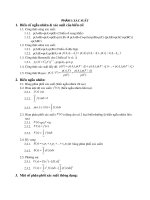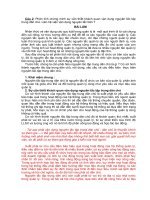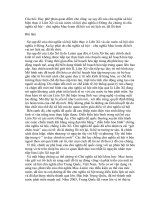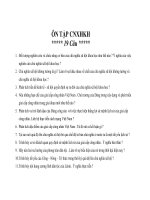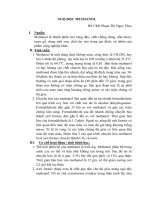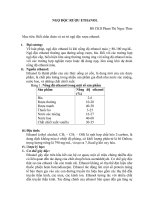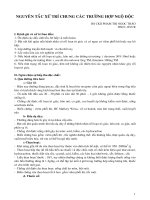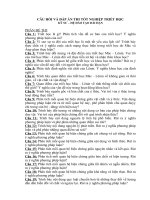Insect Diversity Conservation doc
Bạn đang xem bản rút gọn của tài liệu. Xem và tải ngay bản đầy đủ của tài liệu tại đây (7.62 MB, 356 trang )
This page intentionally left blank
Insect Diversity Conservation
This groundbreaking book is an up-to-date global synthesis of the rapidly
developing and important field of insect conservation biology. Insects are
by farthe most speciose organisms on earth, yet barely known. They play
important roles in terrestrial ecological processes and in maintaining the
world as we know it. They therefore present particular conservation chal-
lenges, especially as a quarter may well become extinct in the next few
decades.
This book first addresses the ethical foundation of insect conservation,
and asks why we should concern ourselves with conservation of a butterfly,
beetle or bug. The success of insects and their diversity, which have sur-
vived the comings and goings of glaciers, is now facing a more formidable
obstacle: the massive impact of humans. After addressing threats, from inva-
sive alien plants to global climate change, the book then explores ways in
which insects and their habitats are prioritized, mapped, monitored and
conserved. Landscape and species approaches are considered. Restoration,
and the role of conventions and social issues are also discussed. The book is
for undergraduates, postgraduates, researchers and managers both in con-
servation biology or entomology and in the wider biological and environ-
mental sciences.
MICHAELJ.SAMWAYS is Professor of Entomology at the University of
Stellenbosch, South Africa. He is internationally known as a conservation
biologist and policy advisor.
Insect
Diversity
Conservation
MICHAEL J. SAMWAYS
University of Stellenbosch, South Africa
Cambridge, New York, Melbourne, Madrid, Cape Town, Singapore, São Paulo
Cambridge University Press
The Edinburgh Building, Cambridge ,UK
First published in print format
- ----
- ----
- ----
© Michael J. Samways 2005
2005
Information on this title: www.cambrid
g
e.or
g
/9780521783385
This book is in copyright. Subject to statutory exception and to the provision of
relevant collective licensing agreements, no reproduction of any part may take place
without the written permission of Cambridge University Press.
- ---
- ---
- ---
Cambridge University Press has no responsibility for the persistence or accuracy of
s for external or third-party internet websites referred to in this book, and does not
guarantee that any content on such websites is, or will remain, accurate or appropriate.
Published in the United States of America by Cambridge University Press, New York
www.cambridge.org
hardback
p
a
p
erback
p
a
p
erback
eBook (NetLibrary)
eBook (NetLibrary)
hardback
Contents
Preface page ix
Cover picture xi
Part IThe need for insect diversity conservation 1
1Ethical foundation for insect conservation 3
1.1 Introduction 4
1.2Environmental philosophy and insect conservation 4
1.3 Insect utility 9
1.4 Insect rights and species conservation 11
1.5Spiritual conceptions 13
1.6 Summary 15
2 The special case of insects in conservation biology 16
2.1 Introduction 16
2.2 Insect radiation 18
2.3 Bauplan, flight and insect conservation 22
2.4 Polymorphisms 23
2.5 Insect diversity and the landscape 25
2.6 Global insect species richness 28
2.7 Survival in prehistorical times 29
2.8 Current extinctions 32
2.9 The taxonomic challenge 33
2.10 The perception challenge 35
2.11 Pest insects and population crashes 36
2.12 Summary 37
3Insects and the conservation of ecosystem processes 39
3.1 Introduction 39
3.2 Insects as keystone organisms 40
3.3 Insect ecosystem engineers and soil modifiers 41
3.4 Insects as food for other animals 42
3.5 Insect dispersal 42
3.6 Insect pollinators 45
3.7 Insect herbivores 46
3.8 Insect parasitoids and predators 49
3.9 Insects and disease 50
v
vi Contents
3.10 Ecosystem diversity and insect diversity 52
3.11 Insects and the naturally changing landscape 52
3.12 Significance of ecological connectance 53
3.13 Summary 54
Part II Insects and the changing world 57
4Degradation and fragmentation of ecosystems 59
4.1 Introduction 59
4.2 Environmental contamination 61
4.3 Pesticides 63
4.4 Agriculture and afforestation 65
4.5 Urbanization and impact of structures 68
4.6 Deforestation and logging 73
4.7 Transformation of grasslands, savanna and
Mediterranean-type ecosystems 78
4.8 Deterioration and loss of aquatic systems 80
4.9 Pressure on special systems 84
4.10 Overcollecting 86
4.11 Summary 87
5Responses by insects to the changing land mosaic 89
5.1 Introduction 89
5.2 Behavioural responses 90
5.3 Population response and local extinction 98
5.4 Community response and long-term prognosis 100
5.5 Genetic changes 107
5.6 Summary 110
6 Threats from invasive aliens, biological control and genetic
engineering 113
6.1 Introduction 114
6.2 Invasive alien plants 114
6.3 Invasive alien vertebrates 118
6.4 Invasive alien insects 119
6.5 Risks of introducing insect natural enemies 124
6.6 Risks of introducing insect pathogens 127
6.7 Risks of genetic engineering 130
6.8 Summary 134
7Global climate change and synergistic impacts 136
Contents vii
7.1 Introduction 136
7.2Ecosystem response to global climate change 137
7.3 Changes in species’ geographical ranges 143
7.4Synergisms and future perspectives 145
7.5 Summary 149
Part III Conserving and managing insect diversity 153
8Methods, approaches and prioritization criteria 155
8.1 Introduction 155
8.2 Towards an ‘Earth ethic’ 156
8.3 Identifying geographical areas for conservation action 158
8.4 Systematic reserve selection 162
8.5 Use of surrogates in conservation planning 163
8.6 Coarse and fine filters 167
8.7 Plant surrogates 173
8.8 Animal surrogates 174
8.9 Phylogenetic considerations 175
8.10 Are ‘umbrella’ and ‘flagship’ species of value in
conservation planning? 176
8.11 Summary 178
9 Mapping, inventorying and monitoring 180
9.1 Introduction 180
9.2 Mapping 181
9.3 Inventorying 186
9.4 Monitoring 192
9.5 Red Listing 195
9.6 Application of IUCN Red List Criteria at regional or
national levels 198
9.7 Insects as bioindicators 199
9.8 Reference sites 203
9.9 Summary 203
10 Managing for insect diversity 206
10.1 Introduction 206
10.2 Importance of parks, reserves and remnant patches 207
10.3 Importance of landscape heterogeneity 212
10.4 Countryside-wide management 215
10.5 Importance of patch size relative to habitat quality 217
10.6 Simulating natural conditions and traditional practices 222
viii Contents
10.7 Corridors 226
10.8 Landscape management in urban areas 231
10.9 Summary 232
11 Restoration of insect diversity 234
11.1 Introduction 234
11.2 Principle of restoration triage 235
11.3 Restoration of species or processes? 237
11.4 Coarse-filter and fine-filter approaches to restoration 240
11.5 Insect gardening 244
11.6 Species-specific recovery plans 246
11.7 Summary 250
12 Conventions and social issues in insect diversity conservation 252
12.1 Introduction 252
12.2 The international arena 253
12.3 National issues 256
12.4 Overcoming the perception challenge 257
12.5 Butterfly houses and increasing conservation awareness 259
12.6 Deadstock trade 261
12.7 Butterfly farming 262
12.8 Summary 263
References 266
Index 316
Preface
Some say that ‘the cockroach’ will be the last species on Earth to survive.
Then it has been calculated that one gravid aphid, left to reproduce with zero
mortality, will, after one year, cover the globe with an aphid layer over 140 km
thick. Not forgetting too, that flies and fleas vector disease. So, why should we
even consider conserving insects? Quite simply, without insects, the likelihood
is that the world as we know it would be radically changed in a matter of days.
Besides, it is only a tiny minority of insects that harm our lives. These two faces
of insects, friend and foe, are just one of the several paradoxes that characterize
insect conservation from other facets of taxon-based conservation biology. Our
impacting on landscapes can turn a benign insect species into a pest, while, on
theother hand, it may cause an extinction of another species. Focusing on the
land mosaic, its composition, structure and function, is thus central to insect
conservation.
We have no idea of the outcomes from our modification of the biosphere.
Blindfolded, we are turning the many faces of the Rubik Cube of biological
diversity conservation in the hope that all the faces will match. It is not that
we are incapable, it is just that the world is so complex. A thousand species,
forexample, in the same community (not an unreasonable figure) potentially
produces 0.5 million interactions. In addition, strengths of those interactions,
and hence outcomes, also vary.
Bleak as this may seem, we are beginning to lift the blindfold and make ration-
al decisions for conserving biological diversity. Insects and their interactions are
amajor component of that diversity. Indeed, insects are virtual ambassadors for
biological diversity. These little animals, by their great variety and abundance,
play an unheralded yet pivotal role in our, and many other organisms’, lives.
We now have a major challenge before us: How do we go about conserving this
largely unseen, unknown majority?
The ambassadorial status of insects for terrestrial and aquatic ecosystems
is the reasoning behind the title ‘Insect Diversity Conservation’. ‘Biological’ is
simply replaced by ‘Insect’. This is not in pursuit of entomological chauvinism
but rather to emphasize that insects are central, yet with many special features,
to biodiversity conservation.
The aim here is to overview and critically appraise the conservation of insect
diversity. It focuses strongly on the variety and differences among insects, and
links these to landscape and other large-scale conservation initiatives. After all,
insects do not rule the world alone. This is not, though, to ignore special cases
where a particular insect species requires particular conservation attention.
ix
xPreface
Conservation cannot be done without clearly defining our feelings and
motives for why we are doing it. This goes beyond simply the utilitarian value of
insects for us. This field of environmental ethics in relation to insects is there-
fore addressed in the first chapter,and is a foundation for all that follows. In
Chapter 2,thespecial case for insects, in comparison with and in contrast to
other organisms, is argued. This is not to say that insect conservation is tangen-
tial to mainstream conservation. Rather, it is central, especially as insects play
so many keystone roles in non-marine ecosystems. These roles and others are
discussed in Chapter 3. These first three chapters together are the launching
point for the rest of the book, and address why there is the need for insect
diversity conservation. Part II (Chapters 4 7) addresses threats to insect variety,
and emphasizes that many of these threats are multiplicative, with one threat
compounding another. Part III (Chapters 8 12)thenreviewstheoptions that we
have to ameliorate these threats.
As insects are now featuring much more strongly in biodiversity conservation,
thefield of insect conservation biology has grown enormously in recent years.
It is clear too that there are many varying, even conflicting conclusions when
various studies are compared. These differences seem to arise mainly from three
different perspectives: differences in spatial scale of the study, differences in
biogeographical regions, and differences in the focal taxa used. This is healthy
and indicative of a rapidly growing field of study. Nevertheless, some general
principles are beginning to emerge, and in terms of management, these are
synthesized in Part III.
Insect conservation has been a rapid growth area in recent years, often with
intense debate. In response, I really do appreciate the stimulating feedback from
Jonathan Ball, Andy Beattie, Steve Compton, Eduardo Galante, Henk Geertsema,
Justin Gerlach, Jeff Lockwood, Melodie McGeoch, Tim New, Paul Pearce-Kelly,
Andrew Pullin, Nigel Stork and Stuart Taylor, as well as the lively minds of
my research students over the years. Many authors kindly made available text
figures, and these are acknowledged with each figure.
This work would not have been possible without the amazing support of
Colleen Louw (processing text), Stuart Taylor (processing figures) and James Pryke
(processing references). Anni Coetzer produced the beautiful cover and text illus-
trations, so rich in symbolism. Ward Cooper and Jo Bottrill saw production of
the book to its completion. My warm thanks to these friends for making this
such an enjoyable enterprise.
Cover picture
In an ever-changing, human-transformed world, we often overlook the
importance of each little creature in our earthly ecosystem. Conscious and moral
Man holds the future well-being of the world in his hand. Yet the race is against
time, that these noble efforts are not in vain. Insects are an ancient, ecologically
significant and beautiful component of the world, symbolized here by the
dragonfly. The variety of insect life around us, be it in our garden or city park,
are a constant reminder that these small but numerous animals are part of
thefabric and health of our planet. By destroying these living creatures and
their habitat, the delicate glass of our ecosystem will shatter, leaving us with a
transformed, bare world, devoid of colour and life as we once knew it. Time is
now short for ensuring the future of this amazing insect diversity.
Anni Coetzer
xi
I The need for insect diversity
conservation
Never use the words higher and lower . . . Certainly, they are difficult words,
not only descriptive but value laden . . . while bald eagles are an endangered
species, so are 129 species of American freshwater mussels . . . Is it more
important to save the eagle than ten dozen species of mussels? Perhaps
eagles and mussels are just there, and neither is higher or lower. Of the
animal biomass on our planet, 90 percent is invertebrates, who account for
95 percent of all animal species.
Charles Darwin (a penned note)
2
The diversity of insect life today is, as far as we know, the richest it has ever been.
The variety is so great that insects make up three-quarters of all species. Insects have
radiated into so many diverse forms that we have been able only to describe a small
fraction of them. They are a major component of all life we see around us. Out of
simple beginnings, the earliest life forms continued to radiate through the process
of variation/selection/retention to endow the earth with a fantastically rich tapestry
of form and colour, of development and dispersal, that has enriched every corner of
terrestrial systems with insect character of some sort. Humans are a latter-day arrival
who hold in their palms the future of the insect mosaic. This insect variety is losing
its spatial and compositional integrity as we enter the new era, the Homogenocene,
which is a mere Blink of a geological eyelid.
1 Ethical foundation for insect
conservation
We may notice thatthetree-hopper, called by the Greeks Tettix,bythe
latins Cicada,received also from the former the title of ‘‘Earth-born,” a
title lofty in its lowliness, because it was an implied acknowledgment from
men of Athens and of Arcady of a common origin with themselves an
admission that the insect was their brother, sprung (as they fabled) from
the earth, their common parent, whence, also, they wore golden tree-
hoppers in their hair.
Acheta domestica (1851)
We feel our world in crisis.
David Rothenberg (1989)
3
4Ethical foundation for insect conservation
1.1Introduction
Conservation action must have a sound philosophical and ethical foun-
dation. This gives the action meaning and direction. It is the ‘why’ we are doing
it. At the most superficial level, that of utility, nature is at our service to be
used, ideally sustainably. In this philosophy, humans have complete dominion
over nature, and this is the language of most international agreements and
conventions.
Deeper levels require more wrestling with thoughts and ideals. Among these
is one philosophical approach where humans and nature are still separate, but
nature is to be admired and enjoyed. An alternative view is that humans are
part of the fabric of nature, and nature is used sustainably yet respected deeply.
In recent years, a more profound environmental philosophy has emerged,
where organisms, including insects, have the right to exist without necessarily
being of any service to humans. A powerful epithet to this deep ecology view
has emerged: that we should appreciate and love other organisms without the
expectation of anything in return.
Different world religions have recognized the environmental crisis and have
made declarations that bridge their faith for the future well-being of the world.
While philosophy is an essential foundation for how we approach conservation
activities, religion is a spiritual complement, which in some countries such as
India can play a significant role at the local scale.
Insect diversity conservation has received an enormous upsurge in recent
years, principally with the recognition of the major role that insects play in
maintaining terrestrial ecological processes. Yet there is recognition too, that
insect individuals and species are being lost at an enormous rate. Stemming
this loss of diversity is a vast task. A philosophical base helps decide on which
value systems we should use to approach the challenge. Religion then provides
spiritual recognition that what we are doing is a good thing. These lead to the
scientific pursuit of insect diversity conservation, which is the subject of the
following chapters.
1.2Environmental philosophy and insect conservation
1.2.1 Ethical foundations
No conservation effort can meaningfully begin without a firm founda-
tion of human value systems or ethics. Such ethics are the language of conserva-
tion strategies. Without some moral guidelines, it is difficult to define our goals
and hence the expected outcomes of conservation activity.
There is little to separate insects from other organismal aspects of biodiversity
in environmental philosophy. A noteworthy exception is that not all insects are
good for each other, or for us. Insects can be parasitoids or disease vectors.
Indeed, we exploit parasitoids as biological control agents.
Environmental philosophy and insect conservation 5
1.1 Aramification of the Resource Conservation Ethic. Mopane ‘worms’ (larvae of the
emperor moth Gonimbrasia belina)are harvested and dried, and considered an impor-
tant source of protein and fat to people in Africa.
At thearguably lowest level of ethical consideration, insects have utilitarian
or instrumental value for us. This includes aesthetic, food, adornment, orna-
ment, service, spiritual and cultural, heuristic, scientific, educational, conser-
vation planning and ecological values. These utilitarian values have two facets.
The first is that they are there for us to enjoy aesthetically and be left alone.
This is the Romantic-Transcendental Preservation Ethic (Callicot, 1990). This goes
beyond just the insects themselves. It considers all their interactions and ram-
ifications with other aspects of nature. It is an ethic that we adopt when we
visit a nature reserve. The second utilitarian facet is that insects are there for
sustainable use (Figure 1.1). This is the Resource Conservation Ethic. The har-
vesting ofhoneyfrom honeybees is an example. But this ethic may apply to a
wider, indirect set of services that insects supply, such as pollination and nat-
ural biological control. Where insects do not fit snugly into this ethic is when
many actually do a disservice to our resources by nibbling, piercing and burrow-
ing into plants, transmitting disease and killing animals. To entertain this ethic
may indeed involve some control of insects.
In both the Romantic-Transcendental Preservation Ethic and Resource Con-
servation Ethic, humans are essentially separate from the rest of nature and
6Ethical foundation for insect conservation
1.2 Building an Evolutionary-Ecological Land Ethic at the smaller spatial scale into
Resource Conservation Ethic at the larger spatial scale. Here remant linkages of grass-
land are maintaining ecological and evolutionary processes, while the landscape as
a whole is also being utilized to produce timber for export (KwaZulu-Natal, South
Africa).
organisms have positive, negative or neutral value. In contrast, Leopold (1949)
articulates in a subtle and charming way that other species have come about
through the same ecological and evolutionary means as humans, and as such,
deserve equal consideration. Humans nevertheless, reserve the right to use and
manage nature as well as there being recognition of the intrinsic value of other
species and the integrity of ecosystems (Figure 1.2). This is the Evolutionary-
Ecological Land Ethic. Rolston (1994) goes a step further, and points out that
culture has now emerged out of nature, which brings with it a responsibility
for humans to nurture other organisms. Samways (1996d)thenillustrates that
culture has now become an evolutionary path and the human self-manipulating
genome the driving force. Ideally, we now need to build into our new genome
an environmental ethic.
1.2.2 World in crisis
The sharp increase in consumerism and human population growth over
thelast few decades has stimulated an acute awareness of the adverse impacts
on the natural environment. A feeling has developed that not all is well in
theworld, and that wild nature, unsullied by humans, may even have ended
(McKibben, 1990). There is also a growing awareness and accumulating evidence
that our world is in crisis but not necessarily doomed (Cincotta and Engleman,
Environmental philosophy and insect conservation 7
2000). Out of these changes has developed a strong movement, that of deep
ecology, which provides a sense of wisdom combined with a course for action
(Naess, 1989). Pessimism is not allowed to prevail, and a sense of joy is the spirit
behind the philosophy.
Deep ecology is not something vague as some have claimed. It is an ontology,
which posits humanity as inseparable from nature, and with an emphasis on
simplicity of lifestyle and on communication with all critics. Naess (1989)termed
this approach ecophilosophy (shortened to ecosophy). It is the utilization of
basic concepts from the science of ecology, such as complexity, diversity and
symbiosis, to clarify the place of our species within nature through the process
of working out a total view (Rothenberg, 1989). This is especially relevant to
insect conservation, as the insect world is indeed complex and diverse, and it
is one where symbioses in the widest sense are widespread. Also, it is at the
core of the landscape approach to conservation, where focusing on individual
species and interactions is insufficient to conserve the vastness of insect diversity.
This emerging arena of ecophilosophy, ecopsychology or transpersonal ecology
is likely to play a role in future conservation (Fox, 1993). Indeed, Johnson (1991)
advances a potent argument on behalf of the morally significant interests of
animals, plants, species and ecosystems. He notes that in a moral world, all
living things, insects included, have a right to survival (Figure 1.3).
1.2.3 Overcoming the impasse between utility and deep ecology theories
Although deep ecology and even some schools of thought in landscape
ecology (Naveh and Lieberman, 1990)include humans in the global ecological
equation, it is nevertheless this very human factor that is threatening the plan-
etary processes that in the past have led to the current, rich world-ecology.
Although deep ecology purports a human omnipotence, the risk here is that
asense of place, and, in turn, places of wild nature, are left out. To ignore
ecological differentials across the globe and to homogenize all would simply
be sad. After all, it is the essence of conservation biology to conserve diver-
sity, which, quite literally, is all the differences within nature and across the
globe.
Norton (2000)argues persuasively that utility (instrumental value) and deep
ecology (intrinsic value) theories are confrontational, and he then asks whether
there is perhaps an alternative, shared value that humans may place on nature.
The instrumental and intrinsic value theories share four questionable assump-
tions and obstacles: (1) a mutual exclusion of each other, (2) an entity, not pro-
cess, orientation, (3) moral monism, and (4) placeless evaluation. To overcome
these impasses, Norton (2000)suggests an alternative value system, which recog-
nizes a continuum of ways that humans value nature. Such a spectrum would
value processes rather than simply entities, is pluralistic and values biodiver-
sity in place. Such a universal earth ethic values nature for the creativity of its
8Ethical foundation for insect conservation
1.3 Aroad sign at Ndumo Game Reserve which emphasizes the ecophilosophy approach
where all creatures have the right to survival, no matter how small or ecologically
significant.
processes (Norton, 2000). This ethic is vital when we consider not only the sus-
tainability of nature, whether for itself or for humans, but arguably and more
importantly, it is crucial for maintaining the evolutionary potential of biodiver-
sity, especially in extensive wild places (Samways, 1994).
The value of wild places is high, and such places are often the seat of inter-
esting, curious and irreplaceable biodiversity. The problem with placing great
emphasis on wild places is that reserves constitute less than 4% of the Earth’s
land surface (World Resources Institute, 1996). This emphasizes that much of
nature is now within a stone’s throw of humans, and the degree of anthro-
pogenic modification varies from very little to very much. This spectrum has
various degrees of ecological integrity. As such, a major goal of conservation is
to conserve as much as possible of this remaining integrity, with due respect
Insect utility 9
to therole of critical processes in maintaining that integrity (Hunter, 2000a).
Indeed, even wild places are only likely to survive in the long run if recognized
as wildland gardens that continue to be used with minimum of damage (Janzen,
1999).
Rolston (1994) has illustrated that there are various types or levels of values:
natural and cultural, diversity and complexity, ecosystem integrity and health,
wildlife, anthropocentric and natural intrinsic. All enter the essence of conserva-
tion biology, and all impinge on insect diversity conservation. It is this diversity
of values, when maintained, that enrich the world, not just for us, but also for
all the other organisms and all the processes that make this, as far as we know,
auniqueplanet.
1.3 Insect utility
Although in practice insects are rarely harvested in the way of many
other organisms, the principle of utility value still applies to them. The most
significant feature of insects in terms of this utilitarian philosophy is to ensure
continuance of their ecological services, so that ecological integrity and health
are maintained (see Chapter 3). This is where we largely do not understand
the consequences of our actions. To name one example, landscape fragmenta-
tion and attrition of landscape patches influence the insect assemblages such
that the services they normally supply may no longer be possible (see Chapters 4
and 5).
In the agricultural context, it is not always possible to maintain ecological
integrity, even though specific insects are being conserved and human intentions
are good. Natural ecosystems adjacent to agricultural fields are often utilized for
pools of natural enemies that invade the crop and control pests. On harvesting
of the crop, the natural enemies then flood back to the surrounding natural
ecosystem where they exert strong, albeit local, impact on natural hosts. This is
amanifestation of the human demand for harnessing the interaction between
host and parasitoid or predator. Biological control is one of the most sought-after
services of insects, and one which is not without risks to ecological integrity
(Figure 1.4).
Ecological services from insects include more than predation and parasitism.
Technical details of these are addressed in Chapter 3.Among these is pollination
of crops, both by wild insects and by captive honeybees. Encouragement of these
pollinating insects can hardly be in excess, as the same insects can play a major
role in maintaining indigenous plants, and hence in their conservation (Kwak
et al., 1996).
One area where insect overexploitation requires caution is in the case of
colourful butterflies. Regulations need to be called into play, with many species
on the IUCN Red List of Threatened Species (Hilton-Taylor, 2000). Local laws also
10 Ethical foundation for insect conservation
1.4 The parasitoid Aphytis melinus an important biological control agent against scale
insects (Diaspididae). Biological control is one of the most sought after services from
insects, but does carry risks (see Chapter 6). Although introduced specifically against
Red scale (Aonidiella aurantii)inSouth Africa, A. melinus is now known to parasitize at
least ten other species.
play a significant part, as does blanket protection of wild areas containing the
habitats of these sought-after species. Insect farming can take pressure off the
wild populations by providing reared specimens that are often in visibly better
condition than wild-caught specimens.
Perhaps the utilitarian aspects of insects have been underexploited. While we
are likely to see only limited progress in the direct harvesting of insects (simply
because they are generally unpredictable, small and difficult to harvest) there
may be some future for medical and novel silk products.
However, the heuristic value of insects in genetic research is undeniable, with
Drosophila melanogaster virtually a household name. The future is likely to see
particular insect genes, rather than the whole animal, having utilitarian value
in many aspects of our lives.
Caring for the Earth (IUCN/UNEP/WWF, 1991), which is a world conservation
strategy, implicitly addresses many facets of insect diversity conservation that
underpin the well-being of humans. Insects and their activities are vital for con-
serving our life-support systems and for renewing our resources through services
in addition to pollination, such as soil maintenance, population regulation, and
Insect rights and species conservation 11
in the food webs of terrestrial invertebrates. The value of insect utility therefore,
is about conservation of insect diversity. This is part of the wider concept of sus-
tainable use of the world’s resources which involves a challenge, among others,
which will require learning how to recognize and resolve divergent problems,
which is to say a higher level of spiritual awareness (Orr, 2002).
1.4 Insect rights and species conservation
Individuals have rights so as to maintain and even improve their lives,
and then they die. So then, do insects have rights? As this is such a difficult
question to answer, it is best to put it in a converse sense. Do we have the right
to assume that insects do not have rights? Bearing in mind the weight of their
collective individuality, best we adopt the precautionary principle of keeping
all the parts. This includes the moral option that, in fact, individual insects do
have rights. From this standpoint, Lockwood (1987)proposes a minimum ethic:
‘We ought to refrain from actions which may be unreasonably expected to kill
or cause non-trivial pain in insects when avoiding these actions has no, or only
trivial, costs to our own welfare.’
This may also be seen as a complement to species preservation, which is
accentuated with increasing rarity of a species. The genotype and phenotype are
naturally locked into a symbiosis. With great rarity and genetic bottlenecks, loss
of individuals has the added responsibility of increasing risk to the species per
se and its evolutionary potential.
It does not mean however, that the individual of an endangered species has
any special rights over the individual of a widespread species. Both have nervous
systems that demonstrate post-inhibitory rebound, both launch pheromones to
attract a mate, and both will avoid a predator if they can. Both too, have an
evolutionary offering to the future. Best we let individuals live (Figure 1.5).
But what of species? Is the fact that 99% of all species that have existed on
earth are now extinct (Novacek and Wheeler, 1992)reallyaconsideration? Per-
haps not when we consider that many clades have evolutionarily advanced and
that there is now more insect diversity on earth than ever before (Labandeira and
Sepkoski, 1993). Yet no two species, or for that matter, subspecies or morphs (evo-
lutionarily significant units, ESUs), are alike, and so all are special. This applies
as much to the parasitoid as to the caterpillar host. Indeed, as polymorphisms
are so rife in the insect world, it is essential to consider the caterpillar as well as
its developmental polymorph, the butterfly. Reality has it, that we have to con-
serve both developmental morphs to preserve the species. The parasitoid and
thebutterfly polymorphism also remind us of the connectedness of all life, and
that species value, in turn, is linked to the value of ecosystems and landscapes,
the conservation of which are essential for maintaining all insect variety and
interactions.
